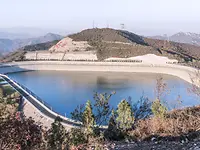As one of the global leaders for hydraulic power generation, ANDRITZ made its mark, in particular with its expertise in low-head pump turbines. For example, with the contract award to supply the pump turbines for the Baixo Sabor Cascade on the Sabor River in northern Portugal, ANDRITZ began a new era of pumped storage development on the Iberian Peninsula. The upstream power station of the Baixo Sabor Cascade is equipped with two pump turbines of 77 MW each. It operates across a very wide head range of between 69 and 105 m. The two pump turbines at the downstream power station operate at a very low head of between 26 and 35 m. In the downstream station each of the units provides a rated capacity of 18 MW. Both grid-connected power stations were built to both generate electricity and create a strategic reserve of water in the region.
A couple of years later, in late 2011, ANDRITZ received an order to supply equipment for another pumped storage plant in Portugal – the 234 MW Foz Tua pumped storage power station. The dam, with two pump turbines, is located on the lower branch of the Tua River. It forms part of a national effort to increase power generation from renewable sources.
Beyond the Iberian Peninsula, ANDRITZ experience in pumped storage technology has allowed other nations to benefit from pumped storage hydropower capacity. For instance, two of the largest pumped storage power plants in Europe use equipment from ANDRITZ.
The Goldisthal plant in Germany was the first variable speed pumped storage power plant outside Japan. The pump turbines at Goldisthal are able to regulate energy not only in turbine mode, but also during pump operation. Additionally, the plant supplies advanced grid services, improving reliability and stability across the national transmission system.
In 2015, the second largest pumped storage plant in Europe, the Vianden power station in Luxembourg, was extended with an 11th pump turbine unit supplied by ANDRITZ. The addition of this new unit, with a rated capacity of 200 MW, boosted the total capacity of the power station to almost 1,300 MW.








